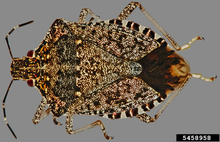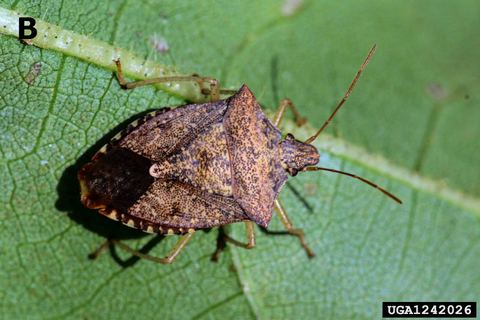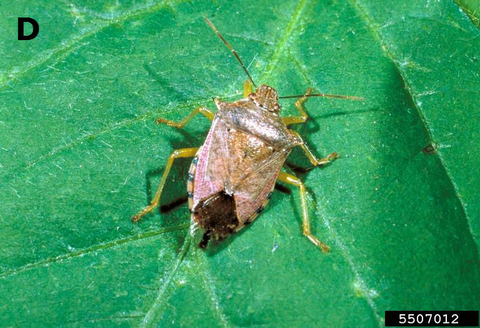Identification of stink bugs (Pentatomidae)
Adults
- Shield-shaped bodies with a triangular structure (scutellum) on their backs.
- 5-segmented antennae.
- Piercing-sucking mouth parts (proboscis).
- Proboscis is narrower than the thickness of the antennae for herbivores, and thicker than the antennae for predators.
Eggs
Eggs are barrel-shaped and often laid under leaves.
Nymphs
- Smaller size and more rounded shape than adults.
- No wings or small undeveloped wings.
- Five nymphal stages (instars).
Natural history
- Most species undergo one to two generations per year.
- Most feed on various crop and wild plants.
- Most overwinter as adults under leaf litter and loose bark, but some are household invaders.
Impacts
- Prefer to feed on pods and developing seeds.
- Penetrate plant tissues with a proboscis, inject digestive enzymes, and remove nutrients.
- Feeding causes abortion, deformation, and discoloration of seed, which can affect yield and quality.
- Feeding can also cause delayed plant maturity ("stay–green syndrome").
Be on the lookout
The brown marmorated stink bug looks similar to some of the Minnesota native species but can be distinguished by light-colored bands on the antennae and the alternating dark-light pattern on the edge of the abdomen.
Under close inspection, the veins of the membranous parts of the wings are outlined in black.
Scouting and management
Stink bugs have infrequently reached economically significant levels in Minnesota, but invasive species and reported increases in abundance of native species could result in increased infestations.
Scouting
- Start scouting as pods begin to develop and continue through seed development.
- Scouting can be performed with a sweep net.
- Stink bugs typically colonize field edges first, so counting should include edge and interior areas.
Treatment thresholds
- Decisions are based on the combined count of nymphs (less than 1/4-inch long) and adults of all plant–feeding species.
- Reasonable thresholds for use in Minnesota are as follows:
- Soybean grown for grain: 10 bugs / 25 sweeps
- Soybean grown for seed: 5 bugs / 25 sweeps
Labeled rates for insecticides should be used for treating stink bugs and follow directions on the product label.
Scout fields after treatment to check for recolonization.
CAUTION: Mention of a pesticide or use of a pesticide label is for educational purposes only. Always follow the pesticide label directions attached to the pesticide container you are using. Be sure that the area you wish to treat is listed on the label of the pesticide you intend to use. Remember, the label is the law.
Reviewed in 2024







